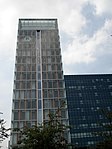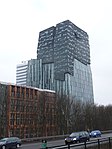Amsterdam Zuid ("Amsterdam South") is a railway station situated in the borough of Amsterdam-Zuid in Amsterdam, Netherlands. For a number of years, it was named Amsterdam Zuid WTC, in reference to the neighbouring World Trade Center Amsterdam. During 2006, in conjunction with the rapid development of the area surrounding the station, the station was enlarged and the reference to the WTC was formally dropped from the name.
As of 2021, Amsterdam Zuid also has a metro station served by 3 lines (50, 51, 52) of the Amsterdam Metro, and two tram stops (Station Zuid and Parnassusweg) served by tram lines 5 and 25.
During 1978, Amsterdam Zuid station opened on a strategic rail route commonly known as the Zuidtak and formed the heart of the modern Zuidas business district, which houses several large banks, accounting and legal firms, as well as being the main public transport gateway for the VU University campus located just south of the station. Over time, the station has played an increasingly important role in Amsterdam's transport strategy and passenger numbers have grown extensively since its opening. To cope with its high patronage, Amsterdam Zuid has been extended and additional services put on; it has effectively replaced the older Amsterdam Centraal station as the capital's main station for direct trains.
During the 2010s, as a means of allowing for further development at the station, a large expansion plan was proposed for Amsterdam Zuid. During December 2014, an agreement for this expansion plan, which has been referred to as the Zuidasdok project, was signed by various public bodies, authorising it to proceed. The publicly funded project has an estimated cost of approximately €1.9 billion; this price tag means it shall be one of the biggest infrastructure projects ever performed in the Netherlands to date. Having received political backing, construction commenced in 2019 and is scheduled for completion around 2028.









